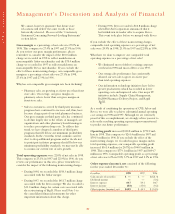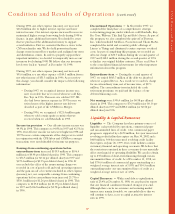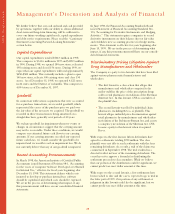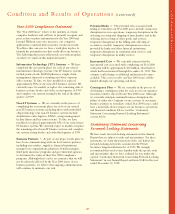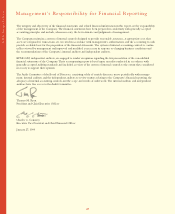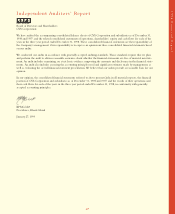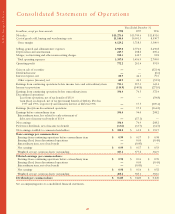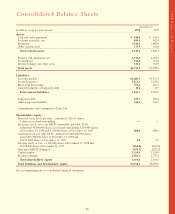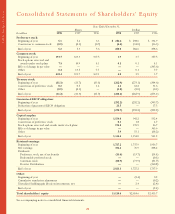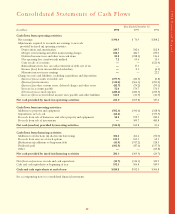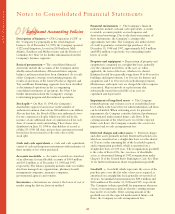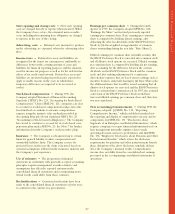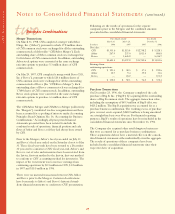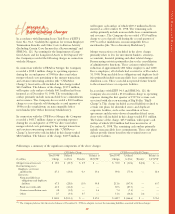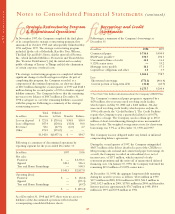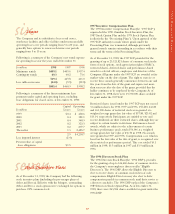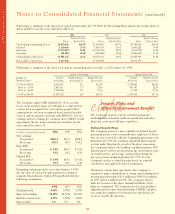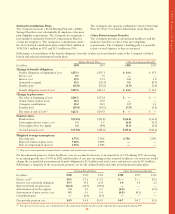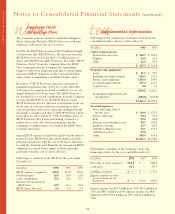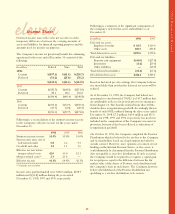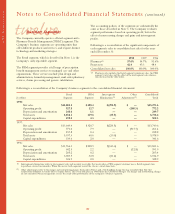CVS 1998 Annual Report Download - page 28
Download and view the complete annual report
Please find page 28 of the 1998 CVS annual report below. You can navigate through the pages in the report by either clicking on the pages listed below, or by using the keyword search tool below to find specific information within the annual report.
26
CVS Corporation
Financial instruments ~ The Company’s financial
instruments include cash and cash equivalents, accounts
receivable, accounts payable, accrued expenses and
short-term borrowings. Due to the short-term nature of
these instruments, the Company’s carrying value
approximates fair value. The Company also utilizes letters
of credit to guarantee certain foreign purchases. As of
December 31, 1998 and 1997, approximately $62.4 million
and $58.2 million, respectively, was outstanding under
letters of credit.
Property and equipment ~ Depreciation of property and
equipment is computed on a straight-line basis, generally
over the estimated useful lives of the asset or, when
applicable, the term of the lease, whichever is shorter.
Estimated useful lives generally range from 10 to 40 years for
buildings and improvements, 3 to 10 years for fixtures and
equipment, and 3 to 10 years for leasehold improvements.
Maintenance and repair costs are charged directly to expense
as incurred. Major renewals or replacements that
substantially extend the useful life of an asset are
capitalized and depreciated.
Impairment of long-lived assets ~ The Company
primarily groups and evaluates assets at an individual store
level, which is the lowest level at which individual cash flows
can be identified. When evaluating assets for potential
impairment, the Company considers historical performance
and estimated undiscounted future cash flows. If the
carrying amount of the related assets exceed the expected
future cash flows, the Company considers the assets to be
impaired and records an impairment loss.
Deferred charges and other assets ~ Deferred charges
and other assets primarily include beneficial leasehold costs,
which are amortized on a straight-line basis over the shorter
of 15 years or the remaining life of the leasehold acquired,
and reorganization goodwill, which is amortized on a
straight-line basis over 20 years. The reorganization goodwill
is the value of Revco D.S., Inc., in excess of identifiable
assets, as determined during its 1992 reorganization under
Chapter 11 of the United States Bankruptcy Code. See Note
11 for further information about reorganization goodwill.
Goodwill ~ Goodwill, which represents the excess of the
purchase price over the fair value of net assets acquired, is
amortized on a straight-line basis generally over periods of
40 years. Accumulated amortization was $85.6 million and
$65.6 million at December 31, 1998 and 1997, respectively.
The Company evaluates goodwill for impairment whenever
events or circumstances indicate that the carrying amount
may not be recoverable. If the carrying amount of the
goodwill exceeds the expected undiscounted future cash
flows, the Company records an impairment loss.
one
Notes to Consolidated Financial Statements
Significant Accounting Policies
Description of business ~ CVS Corporation (“CVS” or
the “Company”) is principally in the retail drugstore
business. As of December 31, 1998, the Company operated
4,122 retail drugstores, located in 24 Northeast, Mid-
Atlantic, Southeast and Midwest states and the District of
Columbia. See Note 12 for further information about the
Company’s business segments.
Basis of presentation ~ The consolidated financial
statements include the accounts of the Company and its
wholly-owned subsidiaries. All material intercompany
balances and transactions have been eliminated. As a result
of the Company’s strategic restructuring program, the
results of operations of the former Footwear, Apparel, and
Toys and Home Furnishings segments have been classified
as discontinued operations in the accompanying
consolidated statements of operations. See Note 4 for
further information about the Company’s strategic
restructuring program and discontinued operations.
Stock split ~ On May 13, 1998, the Company’s
shareholders approved an increase in the number of
authorized common shares from 300 million to one billion.
Also on that date, the Board of Directors authorized a two-
for-one common stock split, which was effected by the
issuance of one additional share of common stock for each
share of common stock outstanding. These shares were
distributed on June 15, 1998 to shareholders of record as
of May 25, 1998. All share and per share amounts presented
herein have been restated to reflect the effect of the
stock split.
Cash and cash equivalents ~ Cash and cash equivalents
consist of cash and temporary investments with maturities of
three months or less when purchased.
Accounts receivable ~ Accounts receivable are stated net
of an allowance for uncollectible accounts of $39.8 million
and $39.2 million as of December 31, 1998 and 1997,
respectively. The balance primarily includes trade receivables
due from managed care organizations, pharmacy benefit
management companies, insurance companies,
governmental agencies and vendors.
Inventories ~ Inventories are stated at the lower of cost or
market using the first-in, first-out method.


